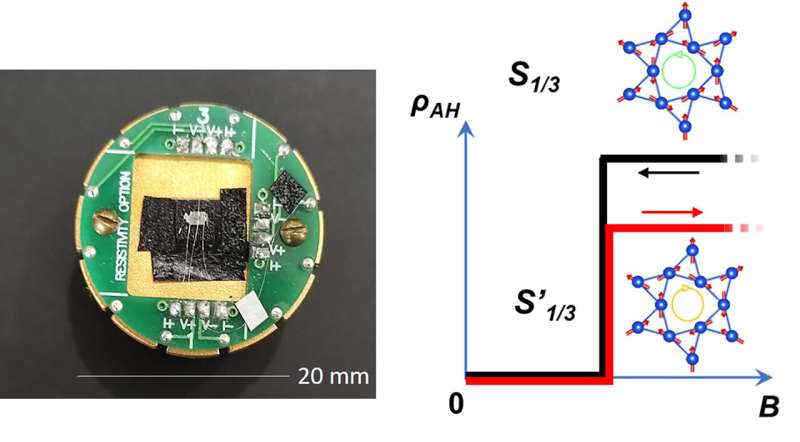This article has been reviewed according to Science X's editorial process and policies. Editors have highlighted the following attributes while ensuring the content's credibility:
fact-checked
peer-reviewed publication
trusted source
proofread
Hall effect uncovers hidden symmetry in spin-ice

Physicists from the University of Augsburg succeeded in distinguishing chiral orders with similar magnetization but an opposite sense of rotation through electrical measurements at low temperatures. This is relevant for fundamental research on complex magnets and possible applications for magnetic data storage. The results were published in Nature Physics.
Electrical currents and magnetic forces are directly linked to each other: Current carrying cables create a circular magnetic field and vice versa a magnetic field deflects electrically charged particles perpendicular to the current and to the field direction. The latter phenomenon is called the "Hall effect" in honor of its inventor Edwin Hall.
The Hall effect is used to probe electric and magnetic properties of metals. The "normal Hall effect" allows us to determine the concentration of charger carriers and their mobility while an additional contribution labeled "anomalous Hall effect" arises in magnets.
At the Institute of Physics at the University of Augsburg it has now been found that the anomalous Hall effect could reveal a hidden symmetry. "Despite an equal magnetization, two states show distinctly different anomalous Hall signals, a surprising and striking observation," explains Philipp Gegenwart, Professor for Experimental Physics.
Right- and left-circulating magnetic pattern
The investigations were done with the magnetic metal HoAgGe, which has special magnetic properties that were discovered four years ago by the team of Prof. Gegenwart. The material features a triangular configuration of atomic electron spins of Holmium atoms.
Since it is impossible to simultaneously fulfill all the pairwise interactions on each triangle, a magnetically frustrated state emerges. It features several energetically degenerate configurations per triangle and is called Kagome spin ice. The spins are located at the edges of corner-shared triangles resembling braided Japanese "Kagome" baskets. Similar rules that apply to water ice determine the possible configurations of the magnetic moments.
In contrast to ordinary magnets, the magnetic moments in Kagome spin ice are not aligned along one direction but rather obey complex chiral pattern, that is, with a differing sense of rotation. They are created in an applied magnetic field at low temperatures and feature fractionalized magnetization plateaus at values of 1/3 and 2/3. The figure above displays two of these patterns with similar energy and 1/3 of the saturation magnetization each.
Possible application for data storage
The study of the research group at the University of Augsburg systematically investigated and analyzed the anomalous Hall effect at low temperatures. Surprisingly, different values of the anomalous Hall effect were found for the two patterns of 1/3 magnetization, visible as red and black curves in the plot in the figure above.
Modeling of the data revealed an underlying unique hidden symmetry: The combination of a 180° rotation and a distortion reversal is required for transforming one pattern into the other one. Conduction electrons scattering off the two different patterns result in different curvatures of the phase of their wave functions, and this leads to a difference in the anomalous Hall effect, despite a similar energy and magnetization of the two different patterns.
More generally, this observation indicates a new potential for measurements of the anomalous Hall effect in magnetically frustrated metals, and for uncovering hidden symmetry and states through electrical measurements. "This may also be interesting with respect to permanent magnetic data storage at smallest atomic scale," says Gegenwart. However, this requires the local addressing and selective switching of the sense of the rotation of these pattern.
More information: K. Zhao et al, Discrete degeneracies distinguished by the anomalous Hall effect in a metallic kagome ice compound, Nature Physics (2024). DOI: 10.1038/s41567-023-02307-w
Journal information: Nature Physics
Provided by University of Augsburg





















